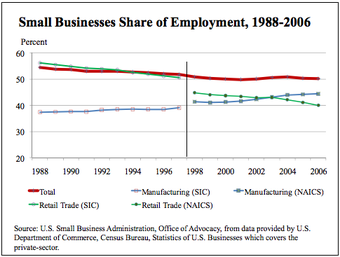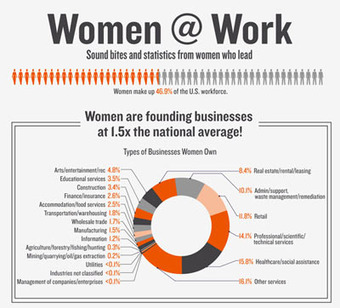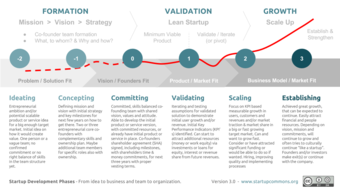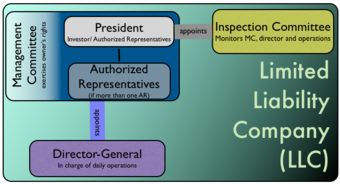7.1: The Small Business
7.1.1: Small Businesses and U.S. Jobs
Half of the U.S. private sector is populated by small businesses and the other half by large businesses.
Learning Objective
Discuss the growth of small businesses in relation to the U.S. economy
Key Points
- The U.S. government often defines small and medium-sized businesses (SMBs, also referred to as small and medium-sized enterprises, or SMEs) as firms with fewer than 500 employees.
- While business has seen great consolidation in recent years, the share of employment in small firms has been relatively stable over the past few decades. Just over half of U.S. employees work for SMBs.
- Small businesses often serve as seeds for new industries, such as Apple and Google did in their early stages. By addressing a need left unmet or innovating more rapidly than large multinational corporations, small businesses are able to carve out new niches for themselves.
- Recent advancements in technology can reduce the amount of capital needed to start a small business and increase opportunities to scale up rapidly and cost efficiently.
- The primary hurdle for most SMBs, particularly when they are starting out, is acquiring funding.
Key Term
- employment
-
The work or occupation for which one is used, and often paid.
The private sector consists of a wide variance in business size, grouped into small, medium, and large organizations. The U.S. government often defines small and medium-sized businesses (SMBs, also referred to as small and medium-sized enterprises, or SMEs) as firms with fewer than 500 employees. Using this definition, just over one-half of the private sector is populated by small businesses and the other half by large businesses.
Employment
While business has seen great consolidation in recent years, the share of employment in small firms has been relatively stable over the past few decades. It has fluctuated slightly in response to economic conditions, declining slightly when the economy is doing well and increasing when the economy struggles. This tracks with the slight decline in the small-business share of employment during the late 1990s and the leveling off in the 2000s.
Entrepreneurship
Small businesses often serve as seeds for new industries, such as Apple and Google did in their early stages. By addressing a need left unmet or innovating more rapidly than large multinational corporations, small businesses are able to carve out new niches for themselves. Recent advancements in technology can reduce the amount of capital needed to start a small business and increase opportunities to scale up rapidly and cost efficiently.

Small businesses’ share of employment, 1988–2006
The small-business share of employment is relatively stable, as shown in the graph above: the bold red line representing all small businesses stays at around 50 to 55% of the total share of employment.
Funding
The problem all (or at least most) entrepreneurs face on a daily basis is funding, particularly when first starting up. While different industries display differing degrees of entry barriers, most small businesses must obtain a certain amount of capital to begin operations. This can come from a variety of places, including:
- Self-financing by the owner through cash, equity, etc.
- Loans from friends or relatives
- Grants from private foundations
- Private stock issue
- Forming partnerships
- Angel investors (i.e. venture capital)
- Bank
7.1.2: The Prevalence of Small Businesses
Industries with high concentrations of small and medium businesses generally do not require enormous capital investment up front.
Learning Objective
Describe the characteristics of industries that are represented largely by SMBs (SMEs)
Key Points
- If you’re going to start a business, it’s important to realize that there are specific forces acting upon each industry that affect profit.
- Industries with high concentrations of small and medium-sized businesses (SMBs) generally do not require an enormous amount of up-front capital investment (i.e., they have lower barriers to entry).
- Goods producers make and sell some sort of physical product or material, while service providers don’t make tangible goods. The service industry tends to be more SMB-friendly, as it (generally) requires fewer assets.
- Manufacturing goods competitively involves being able to do so in high volumes in order to remain cost efficient. This requires a large initial investment of capital and access. As a result, manufacturing is more commonly for larger enterprises.
Key Terms
- service provider
-
An organization that operates in areas such as finance, real estate, or buying products from a wholesaler and reselling them to consumers, but does not make tangible goods.
- goods-producers
-
An company that makes and sells some sort of physical product or material.
Barriers to Entry
If you’re going to start a business, it’s important to realize that there are specific forces acting upon each industry that affect profit. Industries with a high concentration of small and medium-sized businesses (SMBs) generally do not require an enormous amount of capital investment up front. The point here is that barriers to entry are central factors in determining the feasibility of the average business owner entering a given industry.
For example, it is not likely that you would start a company to build airplanes, as that would take a large investment of capital for property, plant, equipment, and labor. Many restaurants and bars, however, require simple premises and easy to find, local ingredients. This is a smaller barrier to entry, thus there are more SMBs in the restaurant industry than in the aerospace industry.
Goods or Services?
When thinking about businesses, it can be helpful to divide them into two sections: goods producers and service providers. Goods producers make and sell some sort of physical product or material, while service providers don’t make tangible goods. The service industry tends to be more SMB-friendly, as it (generally) requires fewer assets.
In the United States, roughly 20% of SMBs are concentrated in the goods-producing sector. The 80% of SMBs that reside in the service-providing sector is largely a reflection of the overall U.S. economy (services over goods), as well as the greater feasibility of service industries for small-scale entry.
The high concentration of SMBs in the service-providing sector also reflects a few realities of business. In a global economy, manufacturing goods competitively involves being able to do so in high volumes in order to remain cost efficient. This requires a large initial investment of capital and access to low-cost labor, which are both tough for SMBs to access domestically. Maintaining quality across hundreds of locations in the service-providing sector is also, as you might imagine, not an easy task.

Small-business owner
Small businesses often begin in the services sector due to a number of factors.
7.2: Small Business Owners: A Profile
7.2.1: Key Characteristics of Entrepreneurs
Successful entrepreneurs have a unique set of personal characteristics, including the drive to take risks and embrace failure.
Learning Objective
Discuss the factors that drive entrepreneurs to succeed
Key Points
- Entrepreneurs must be willing to accept risk and failure. The key is that when you fail, you must fail quickly and inexpensively. Test, analyze, figure out why you failed, evolve, and iterate. That is the meaning of drive.
- Focus and energy are two key attributes of drive. Unwavering diligence is required in light of the challenges that the entrepreneur is likely to face, and the ability and desire to work long hours in pursuit of that goal is necessary.
- Entrepreneurs often operate on limited budgets. This requires a great deal of frugality and self-discipline, both useful facets of a strong drive.
- It is also important that drive is directed toward some outcome, and that this outcome has the clarity required to derive perseverance. Vision, passion, and focus enable this.
Key Terms
- entrepreneur
-
A person who organizes and operates a business venture and assumes much of the associated risk.
- creativity
-
The quality or ability to create or invent something.
- perseverance
-
Continuing in a course of action without regard to discouragement, opposition, or previous failure.
Drive and Entrepreneurship
The reasonable man adapts himself to the world; the unreasonable one persists in trying to adapt the world to himself. Therefore all progress depends on the unreasonable man. —George Bernard Shaw
Develop success from failures. Discouragement and failure are two of the surest stepping stones to success. No other element can do so much for a man if he is willing to study them and make capital out of them. —Dale Carnegie
Key Characteristics of Entrepreneurs
Entrepreneurs must be willing to accept risk and failure. The key is that when you fail, you must fail quickly and inexpensively. Test, analyze, figure out why you failed, evolve, and iterate. That is the meaning of drive.

Mark Cuban
Mark Cuban started Broadcast.com and became a billionaire. The most fascinating characteristic about him is that he is not content. He works relentlessly and has invested in hundreds of companies.
Entrepreneurs often possess immense focus and energy. Entrepreneurship requires extensive mental strength and determination because, as opposed to traditional occupations, there is no right or wrong path to achievement. Competition is intense and innovation is required to face the challenges that result from starting your own business.
Entrepreneurial Attributes That Enable Drive
Entrepreneurial drive is something of an umbrella term for the wide variety of characteristics that compel an individual to pursue a unique and untested path relentlessly, regardless of the failures and obstacles. The characteristics below all overlap with drive in some way, shape, or form, to ultimately create a template for the entrepreneurial mentality:
Vision: The entrepreneur must be able to create and communicate an easily understandable vision of what the new venture does in order to successfully launch a new business. This is accomplished while inspiring others to join you in your new enterprise.
Creativity: The entrepreneur must be able to inject imagination and uniqueness into a new business venture. It takes skill and ingenuity to create a new venture equipped with strategies to outsmart the competition.
Focus: The entrepreneur must be able to maintain the vision of the company with unwavering diligence. It’s very easy to get sidetracked, especially if you find it necessary to adapt the original vision. Ironically, there are many successful entrepreneurs who get bored easily.
Passion: Entrepreneurs must have a desire to succeed in a business venture under their own initiative.
Perseverance: The entrepreneur must be able to keep going even when faced with seemingly insurmountable obstacles.
Opportunistic nature: The entrepreneur must take advantage of an upcoming trend or unite unrelated processes to create a unique business venture. It helps, of course, to see the possibilities before they even exist.
Problem-solving ability:The entrepreneur must thrive on coming up with solutions to complex challenges.
Self-discipline: The entrepreneur must be organized and regimented in pursuit of a successful business venture. This includes frugality, which is knowing how to stretch every cent so that expenditures are as low as possible.
7.2.2: The Demographics of Modern Entrepreneurs
Due to technological aptitude, unemployment, and lack of dependents, a sizable percentage of U.S. entrepreneurs are young.
Learning Objective
Identify the demographic trends in modern entrepreneurs, and the factors which influenced them.
Key Points
- With recent technological developments, starting a business requires far less capital than ever before.
- With new technologies and business infrastructure, businesses can be scaled up and replicated in other places much more easily than ever before.
- As a result of recent economic downturns and technological advances, younger generations have higher unemployment rates and are better equipped technologically, which has led to growth in youth entrepreneurship.
- Women are now a dominant force in small-business ownership, and they are succeeding in industries that were once taboo for women.
Key Term
- Barriers to entry
-
One of Porter’s five forces; these are the financial and nonfinancial obstacles for new entrants to entering a given industry.
Example
- A very simple and small-scale example of how technology has made entrepreneurship potentially simpler is the rise of smartphone technology. Nowadays, anyone with an innovative idea and knowledge of smartphone programming is able to develop an original app and release it commercially.
Entrepreneurs are catalysts for economic change. Research suggests that entrepreneurs are highly creative individuals with a tendency to imagine new solutions by finding opportunities for profit or reward. The ability of entrepreneurs to innovate is thought to relate to innate traits such as extroversion and a proclivity for risk taking.
Enabling Factors
There are entrepreneurs in all demographics and walks of life. There have never been lower barriers to entry when starting a new company. Thanks to developments in technology, less capital than ever before is required to start a business (depending on the industry). Moreover, advancements in engineering have allowed people to build software and Internet businesses from scratch with minimal obstacles.
The venture-capital sector has risen from nothing 40 years ago to investing billions in new businesses today. Technology has allowed for business to be scalable over a variety of countries and continents. Previously, scaling a new business would have taken extensive time, focus, and capital. Now there is infrastructure in place (e.g., the Internet, FedEx and UPS, and smartphones) that allows entrepreneurs to build a business that can be replicated in different cities globally.
Couple this with slow economic growth due to the banking collapse in the U.S. and a high number of over-educated and underemployed people and you get a great deal of people who are drawn to entrepreneurship as a way of creating their future.
Youth
All of these factors contribute to the trend of younger and younger business owners. The tendency of young people to take risks, coupled with the relative ease of starting a business in today’s environment, has driven down the average age of entrepreneurs. Also, the younger generations (i.e., recent graduates) are facing high levels of underemployment as a result of economic factors. The younger entrepreneurs also have an interest in and familiarity with technology that provides some advantage.
Organizations have even risen to service the ever-younger, emerging entrepreneurs. The Young Entrepreneur Council (YEC) is an American nonprofit organization that provides entrepreneurs with access to tools, mentorship, and resources that support each stage of their business’s development and growth. The organization has several hundred members—all successful young entrepreneurs and business owners, ages 17 to 40—including the founders and leaders of LivingSocial, Airbnb, Reddit, College Hunks Hauling Junk, Mint.com, myYearbook, Thrillist, Yodle, Threadless, ModCloth, Grasshopper, Likeable, HootSuite, and Blip.tv.
Trends and Statistics of Women in Business

Female entrepreneurship
Recent years have seen a dramatic rise in the number of businesses owned by female entrepreneurs. As the image shows, women are now founding businesses at a rate 1.5 times the national average; the most prevalent such businesses include healthcare / social assistance (15.8%) and professional / technical services (14.1%).
There are exciting things happening inside the world of female entrepreneurship. Women are now a dominant force in small-business ownership and they are succeeding in industries that were once taboo for women. Women are not only starting businesses, they are staying in business. Between 1997 and 2006, female-owned businesses grew at nearly twice the rate of all U.S. firms (42.3 percent vs. 23.3 percent). During the same time period, employment among female-owned firms grew 0.4 percent and annual sales grew 4.4 percent. In 2006, reports on women-owned (or majority owned by women) businesses in the United States returned the following impressive statistics.
- There were an estimated 10.4 million privately-held firms.
- These firms accounted for two in five (40.2 percent) of all businesses in the country.
- These firms generated $1.9 trillion in annual sales and employed 12.8 million people nationwide.
7.2.3: Trends in Business Owners: Age and Gender
Due to technology, unemployment and lack of dependents – a sizable portion of U.S. entrepreneurs are young risk-takers.
Learning Objective
Explain how new technologies are allowing more young people and women to become entrepreneurs
Key Points
- With recent technological developments, starting a business requires far less capital than ever before.
- With the new technologies and business infrastructure, businesses can be scaled up and replicated in other places much more easily than ever before.
- As a result of recent economic downturns and technological advances, younger generations are better equipped technologically and underemployed professionally. This has led to growth in youth entrepreneurship.
- Women are now a dominant force in small business ownership, and succeeding in industries that were once taboo for women.
Key Term
- entrepreneurs
-
People who organize and operate a business venture and assume much of the associated risk.
Example
- A very simple and small-scale example of how technology has made entrepreneurship potentially simplier is the rise of smartphone technology. Nowadays, anyone with an innovative idea with commercial potential, and the knowledge of smartphone programming, is able to develop an innovative and original app, and release it commercially.
Entrepreneurs are catalysts for economic change. Researchers suggest that entrepreneurs are highly creative individuals with a tendency to imagine new solutions by finding opportunities for profit or reward. The ability of entrepreneurs to innovate is thought to relate to innate traits such as extroversion and a proclivity for risk-taking.
Demographics of Entrepreneurs
Enabling Factors
There are entrepreneurs in all demographics and walks of life. There have never been lower barriers to entry when starting a new company. Thanks to developments in technology, there is less capital required than ever before to start a business (depending on the industry). Moreover, advancements in engineering have allowed people to build software and internet businesses from scratch with minimal obstacles.
The venture capital sector has risen from nothing 40 years ago to investing billions in new businesses today. Technology has allowed for business to be scalable over a variety of countries and continents. Previously, scaling a new business would have taken extensive time, focus, and capital. Now, there is infrastructure in place, such as the Internet, FedEx and UPS, and smartphones, which allow entrepreneurs to build a business that can be replicated in different cities globally.
Couple this with slow economic growth due to the banking collapse in the U.S., and a high degree of the over-educated and underemployed, a great deal of people are drawn to entrepreneurship as a way of creating their future.
Youth
All of these factors contribute to the trend of younger and younger business owners. The tendency of young people to take risks, coupled with the relative ease of starting a business in today’s environment, has driven down the average age of entrepreneurs. Also – the younger generations (i.e. recently graduates) are facing high degrees of underemployment as a result of economic factors. The younger entrepreneurs also have an interest and familiarity with technology that provides some advantage to innovating with those fields.
Organizations have even risen to service the ever-younger sector entrepreneurs. The Young Entrepreneur Council (YEC) is an American non-profit organization that provides entrepreneurs with access to tools, mentor-ship, and resources that support each stage of their business’s development and growth. The organization has several hundred members, all successful young entrepreneurs and business owners, ages 17 to 40—a group that includes the founders and leaders of LivingSocial, Airbnb, Reddit, College Hunks Hauling Junk, Mint.com, myYearbook, Thrillist, Yodle, Threadless, ModCloth, Grasshopper, Likeable, HootSuite, and Blip.tv.
Trends and Statistics for Women in Business
There are exciting things happening inside the world of female entrepreneurship. Women are now a dominant force in small business ownership, and succeeding in industries that were once taboo for women . Women are not only starting businesses, they are staying in business. Between 1997 and 2006, female-owned businesses grew at nearly twice the rate of all U.S. firms (42.3 percent vs. 23.3 percent). During this same time period, employment among female-owned firms grew 0.4 percent, and annual sales grew 4.4 percent. In 2006, reports on women-owned (or majority owned by women) businesses in the United States returned the following impressive statistics.
- There were an estimated 10.4 million privately-held firms;
- These firms accounted for two in five (40.2 percent) of all businesses in the country;
- These firms generated $1.9 trillion in annual sales and employed 12.8 million people nationwide.

Female Entrepreneurship
Recent years have seen a dramatic rise in the number of businesses owned by female entrepreneurs. As the image shows, women are now founding businesses at a rate 1.5 times the national average; the most prevalent such businesses include healthcare / social assistance (15.8%) and professional / technical services (14.1%).
7.2.4: The Impact of Business Owners on Success and Failure Rates
As the creator, organizer, and manager of a business, a business owner is critical to the success or failure of a given venture.
Learning Objective
Recognize the significant impact a business owner has on the success of a small business
Key Points
- As the creator of a small business, and the primary source of strategic direction, business owners have substantial impact on the success or failure of a venture.
- Business owners are often tasked with the ability to build a business plan, hire a team, communicate a vision, and carry out a variety of core operations all on their own.
- Due to the number of hats a business owner is likely to wear when running their own organization, the capabilities of the owner will be closely related to the capabilities of the organization itself.
- Due to the high importance of a business owner’s tasks, and the inability to distribute risk across a high number of employees and work groups, a business owner shoulders a great deal of accountability for both success and failure.
Key Terms
- tactics
-
Operational approaches to pursuing goals.
- strategy
-
A plan of action designed specifically to accomplish a given objective or goal. In business, the foundation of how a business accomplishes its objectives.
Why Business Owners Matter
An entrepreneur or a small business owner is generally defined as an individual who creates, organizes, and manages an enterprise with considerable initiative (and usually shouldering considerable risk alongside it). Whatever the project, the business owner tends to sit firmly at the heart of the strategy, tactics, and structure that defines the organization.
As a result of this, the business owner is a central source of advantage (or potentially disadvantage) when executing the operations of the organization. Simply put, the success or failure of a small organization is inherently tied to the central figure who starts, organizes, and manages it.
What Determines Success or Failure
There are countless factors that determine success or failure when starting and running your own business. Each business is different, operating in a different competitive environment with different demands. Without getting too specific or detailed, there are a few central skills commonly required of owners across most small businesses:
Strategy
The first thing a business owner needs is a plan that lays out the strategy of their organization. This critical piece of guidance lays the foundation for how and why decisions are made. As the business owner is most commonly the author of this document, she will also be the person who determines the broader strategic strokes that guide the business in the short and long term.
Team
Another key consideration of a business owner is who (if anyone) to bring on board alongside them. Talent is an expensive business asset and the financial impact of good (or poor) hires can have an enormous effect on the quality of the organization. Leadership of a team to create synergy and ensure alignment is also of central importance and by default the responsibility of the owner.
Communication
Along similar lines, business owners need the capacity to communicate their vision to stakeholders. This includes customers, investors, potential hires, and partners. The ability to sell the idea itself is therefore another critical success factor for any business owner.
Relevant Skills
Different businesses require different skills. A small business owner involved in building websites will need the core relevant skills to create them from scratch. A small consulting group in a given industry will need extensive experience, contacts, and knowledge uniquely valuable to other incumbents in the industry. In short, most small business owners are the primary source of relevant skills for that particular business model (at least at first).
How This Impacts Success Rates
Combining the core importance of the business owner in the creation of the business and the variety of skills business owners can leverage to achieve success, business owners are often enough the primary influence on a small business’ potential success (and potential failure).
Business owners with a strong strategic ability to plan, highly developed interpersonal skills, key industry skills/knowledge, and the willingness to take risks and be accountable are poised for the highest rates of success in small business ventures.
Going into business for yourself can be highly rewarding financially and fulfilling personally. However, entrepreneurship is notoriously linked with failure, and in such situations the entrepreneur is usually the one left wondering where they may have gone wrong.
7.3: Small Business Owners: The Disadvantages
7.3.1: Stress
Small business owners may encounter significant stress due to the high risk of running a small business and the wide variety of competencies required of the job.
Learning Objective
Understand the distinct trade off in owning a small business, most notably when it comes to stress
Key Points
- While owning a small business is a great way to free yourself from working for somebody else, it comes with a few disadvantages as well.
- Running a small business can easily cause a great deal of stress, primarily due to the fact that the owner is taking all the risk (and thus all of the consequences, be they positive or negative).
- Small business owners are also expected to wear many hats, and fill a wider variety of functions than a regular employee would normally be asked.
- When hiring employees, the small business owner is now also responsible for their well-being. Owners with employees must be leaders, and they must manage complex HR processes (or outsource them at a cost).
- When considering starting a company, one should first assess their comfort with uncertainty and risk, as well as their ability to maintain calm in complex situations.
Key Terms
- ambiguity
-
The state of being unclear or unable to measure.
- risk aversion
-
This is a characteristic of individuals who are not comfortable with uncertainty, particularly when capital is on the line.
Why the Stress?
Being a small business owner creates a great deal of freedom, but that freedom comes with some cost. There are various ways to define the difficulties small business owners confront, but the term stress manages to cover a fair bit of the disadvantages small business owners face.
Risk and Return
As the sole owner and operator, all of the risk and all of the return rests on the shoulders of the small business owner. As a result, the small business owner has greater control of the process, but faces much greater consequences for failure and a higher vulnerability to chance. The upsides are higher, the downsides are lower. This basic principle of risk and return can generate a great deal of stress for people aiming high in their own start up ventures.
To be slightly more specific, Frank Knight and Peter Drucker define entrepreneurship in terms of risk-taking. They point out three types of uncertainty encountered by start up owners:
- Risk – Measured statistically and often planned for, risks are simply the probabilities of unfavorable outcomes compared to the desired objectives.
- Ambiguity – A risk that is not measurable, ambiguity is the scenario in which objectives and relative risks are known, but not the likelihood of an outcome.
- True Uncertainty – The worst of all is true uncertainty. The objective is known, but the context of risk is completely unknown.
Any of these three risk scenarios are stressful for many people, and it it is important to understand your own risk aversion before entering into a small business ownership situation.
Competencies Required
In addition to taking all of the risk, small business owners and entrepreneurs are also often tasked with wearing a lot of hats (i.e. working tons of different roles within the organization). As businesses grow, they often become more complex. As that complexity rises, small business owners rarely have the excess capital to invest in a proper team. As a result, they often end up trying to fill as many roles as possible. This requires both a great deal of energy, and a wide variety of competencies. Developing these skills and applying them every day can be both tiring and stressful.

Starting A Business
This is a simple chart that graphs the six steps a start up owner will go through in order to establish a small business. Ideating, concepting, committing, validating, scaling and establishing all require different competencies and capabilities, which the start up owner may have to accomplish herself (or with a small team).
Employees
Another source of stress is the simple fact that employees will be relying on the business owner (if it is a business with a small team). These employees will have needs the leader must fill, and the success of the organization will have a great impact on their job security. Worrying about oneself and one’s success is one thing, but worrying about the livelihoods of the team is another entirely. This can be a great source of stress, depending on the situation.
Other Factors
While these are a few key contributors to stress, it is also worth noting the likelihood of inconsistent revenue (and therefore salary), personal liability (the risk of losing whatever start up capital the business owner invested), payroll, taxes, managing stakeholders (if applicable) and a wide variety of other responsibilities and tasks which can contribute a stressed mentality.
Small business owners therefore benefit greatly from a naturally calm disposition, comfort with uncertainty, and a natural knack for learning multiple competencies and balancing a wide array of responsibilities.
7.3.2: Low Success Rate
Small Business Administration statistics show that one-third of all new businesses fail after two years, and 56% fail after four years.
Learning Objective
List the 10 most common problems entrepreneurs face when starting a new business
Key Points
- Most businesses fail because they lack enough cash at first and take on excessive debt as a result.
- Cash on hand is king! This needs to be the golden rule for start-ups and small businesses. Many entrepreneurs and small business owners have a fundamental misconception of how business operates.
- When the going gets tough, small businesses fail. In part, that’s because most start-ups and small businesses fail to set aside cash reserves that can be tapped into when the market sours.
- Too many owners grow their business too quickly without really determining whether they should, or even whether they can afford it.
- Too many retail owners are not savvy negotiators and sign what they think are “cheap” leases. Consider all factors before signing on the dotted line.
- Too many times start-ups and small businesses lack any type of work process necessary to ensure that things are done consistently. Poor controls and unclear processes can lead to quick failure.
- 7. Poor or No Business Plan. If you fail to plan, you’re planning to fail. A well drafted business plan is your road map to success. If nothing else, having to write a business plan forces you to think about the what, when, where, how and why of your business.
- 8. Ineffective Marketing and Self-Promotion. People can’t buy what you have to offer if they don’t know it is available. Many small businesses fail to develop an effective marketing strategy, or set aside enough money to implement it.
- 9. What Competition? Loyalty is earned not bought. An existing customer who is willing to purchase your product or service again is your best customer. Establishing relationships with customers is vital.
- 10. Failure to Accept, Nay Encourage, Change. Those who don’t adapt … die. Stay alert. Recognize opportunities and remain flexible to adapt to changing times. Better yet, drive the changes.
Key Terms
- Promotion
-
Promotion represents all of the methods of communication that a marketer may use to provide information to different parties about the product. Promotion comprises elements such as: advertising, public relations, personal selling and sales promotion.
- Competition
-
Competition in biology, ecology, and sociology, is a contest between organisms, animals, individuals, groups, etc., for territory, a niche, or a location of resources, for resources and goods, for prestige, recognition, awards, mates, or group or social status, for leadership; it is the opposite of cooperation.
Example
- Pets.com was a former dot-com enterprise that sold pet supplies to retail customers. It began operations in August 1998 and closed in November 2000. A high profile marketing campaign gave it a widely recognized public presence, including an appearance in the 1999 Macy’s Thanksgiving Day Parade and an advertisement in the 2000 Super Bowl. Its popular sock puppet advertising mascot was interviewed by People magazine and appeared on Good Morning America. Although sales rose dramatically due to the attention, the company was weak on fundamentals and actually lost money on most of its sales. Its high public profile during its brief existence made it one of the more noteworthy failures of the dot-com bubble of the early 2000s. Three hundred million dollars of investment capital vanished with the company’s failure. The company was headquartered in San Francisco, California, U.S.
According to the Small Business Administration (SBA), thirty-three percent of new small businesses fail within the first two years. Fifty-six percent fail within the first four years. You can increase the odds of success by knowing the 10 common problems small business owners face.
Not Enough Cash
Most businesses fail because they lack enough cash at first and take on excessive debt as a result. Before you set off on your adventure, make sure that you have sufficient cash to operate for the next 12 months, using your worst case scenario.
Spending Too Much, Too Early
Cash on hand is king! This needs to be the golden rule for start-ups and small businesses. Many entrepreneurs and small business owners have a fundamental misconception of how business operates. As a result, many spend their seed money, or start-up capital, before revenues start rolling in.
No Rainy Day Cash
When the going gets tough, small businesses fail. In part, that’s because most start-ups and small businesses fail to set aside cash reserves that can be tapped into when the market sours.
Growing Too Big, Too Fast
Too many owners grow their business too quickly without really determining whether they should, or even whether they can afford it.
Location, Location, Location
Too many retail owners are not savvy negotiators and sign what they think are “cheap” leases. Consider all factors before signing on the dotted line.
Inexistent Internal Controls or Poor Execution of Existing Controls
Too many times start-ups and small businesses lack any type of work process necessary to ensure that things are done consistently. Furthermore, small business owners and entrepreneurs generally lack the experience and skills to hire the right people, monitor their performances, and deal with them when they don’t work out.
Poor or No Business Plan
If you fail to plan, you’re planning to fail! A well-drafted business plan is your road map to success. If nothing else, having to write a business plan forces you to think about the what, when, where, how, and why of your business.
Ineffective Marketing and Self-Promotion
People can’t buy what you have to offer if they don’t know it is available! Sounds logical? Yet many small businesses still fail to develop an effective marketing strategy, or set aside enough money to implement it.
Competition
Loyalty is earned, not bought. An existing customer who is willing to purchase your product or service again is your best customer. Don’t lose him or her. Make sure that your customer has a reason, or better yet multiple reasons, to continue doing business with you instead of your competition.
Failure to Accept Change
Recognize opportunities and remain flexible to adapt to changing times. Better yet, drive the changes. This holds especially true for your work processes. Constantly ask yourself and your employees, if you have any, what is working and what is not. Always question how things are done and wonder how they could be improved.

Business Failure
Everything must go
7.4: Starting a Small Business
7.4.1: The Business Plan
A business plan is a formal statement of a set of goals, the reasons they are believed attainable, and the plan for reaching those goals.
Learning Objective
Name the components that make up a business plan
Key Points
- The key elements of a business plan include a comprehensive set of relevant information—from market analysis to company financials.
- If the company is seeking funding the business plan gives potential investors an understanding of your proposed business and the money required.
- The business plan is a critical vehicle for communicating both internally and externally how a company intends to conduct business.
- A business plan establishes goals and objections that allow the leadership to assess how well a company is doing based on its established goals and objections.
Key Terms
- business plan
-
a summary of how a venture owner, manager, or entrepreneur intends to organize an entrepreneurial endeavor and implement activities necessary and sufficient for the venture to succeed
- Executive Summary
-
The executive summary is a snapshot of your business plan as a whole and touches on your company profile and goals.
- Financial Projections
-
The financials provide information on the proposed spending and revenues of the company, typically for the first 3 to 5 years of operation. Again ,if funding is required this section details the expected cash flows and other critical financial projections to allow potential investors to understand the risks and returns they can expect
- market analysis
-
Provides the specific industry, market, and competitive analysis information needed to understand where and how the company is positioned in the overall market.
Example
- Elements of a Business Plan: Cover sheet, Executive summary (statement of the business purpose), Table of contents, Body of the document, Business Description of business, Marketing Competition, Operating procedures, Personnel Business insurance, Financial data, Loan applications, Capital equipment and supply list, Balance sheet Break-even analysis, Profit and loss statements, Three-year summary, Detail by month — first year, Detail by quarters — second and third year, Assumptions upon which projections were based, Pro-forma cash flow, Supporting documents, Tax returns of principals (partners in the business) for last three years, Personal financial statements (all banks have these forms), Copy of franchise contract and all supporting documents provided by the franchisor (for franchise businesses), Copy of proposed lease or purchase agreement for building space, Copy of licenses and other legal documents, Copy of resumes of all principals, Copies of letters of intent from suppliers, etc.
A business plan is a formal statement of a set of business goals, the reasons they are believed attainable, and the plan for reaching those goals. It may also contain background information about the organization or team attempting to reach those goals. Business plans may also target changes in perception and branding by the customer, client, taxpayer, or larger community.
Essential Elements of a Business Plan
The key elements of a business plan include a comprehensive presentation of relevant information, from market analysis to company financials. If the company is seeking funding, the business plan gives potential investors an understanding of your proposed business and the money required. The following categories are important inclusions in any business plan:
- Business Plan Executive Summary: The executive summary is a snapshot of your business plan as a whole and touches on your company profile and goals. This section offers tips on what to include and how to keep it brief and succinct.
- Market Analysis: Provides the specific industry, market, and competitive analysis information needed to understand where and how the company is positioned in the overall market.
- Company Description: Company description answers certain questions. What do you do? What differentiates your business from current providers? Which markets do you serve?
- Marketing & Sales Management: The marketing and sales section explains how the company plans to market your business and what is your sales strategy. It outlines in the broadest sense how your firm will communicate with potential customers and suppliers.
- Service or Product Line: Service and product lines details exactly what your firms sells and how does it deliver value to your customers. Information about the firm’s R&D activities and the product lifecycle should be included in this section.
- Funding Request: If you are seeking funding for your business, find out what information you need to include in your plan to ensure success.
- Financial Projections: The financials provide information on the proposed spending and revenues of the company, typically for the first 3 to 5 years of operation. Again ,if funding is required this section details the expected cash flows and other critical financial projections to allow potential investors to understand the risks and returns they can expect.
- Appendix: An appendix is optional, but a useful place to include resumes of the leadership team, permits, leases, and and any other pertinent information that is material to the operations of the company.

Business Plan
Preparing A Business Plan
7.4.2: Types of Ownership
A company has several options when it comes to the legal structure of ownership.
Learning Objective
Discuss the different types of ownership available to small business owners
Key Points
- A small business is a business that is privately owned and operated, with a small number of employees and a relatively low volume of sales.
- Market factors and other key criteria, such as tax implications, should be considered with regard to the legal structure of a company.
- Each of the types of ownership comes with its own inherent advantages and disadvantages and as a result its own risks and potential rewards.
Key Terms
- limited liability
-
A situation in which the liability of the owners of a business is limited to the full, paid-up value of the share capital. In the United States and some other countries, a limited company is known as either a corporation or a limited liability company (LLC).
- partnership
-
A partnership is a form of business in which two or more people operate for the common goal of making profit. Each partner has total and unlimited personal liability of the debts incurred by the partnership.
- Sole Proprietorship
-
A business owned by one person. The owner of the business has total and unlimited personal liability of the debts incurred by the business.
Example
- A smaller business is more flexible. Larger businesses or those with wider ownership or more formal structures, will usually tend to be organized as partnerships or (more commonly) corporations. Generally speaking, shareholders in a corporation, limited partners in a limited partnership, and members in a limited liability company are shielded from personal liability for the debts and obligations of the entity, which is legally treated as a separate “person. ” This means that if the business does not succeed, the owner’s own possessions are strongly protected under the law unless there is misconduct. Partnerships cannot be taken public.
Types of Ownership
A small business is a business that is privately owned and operated, with a small number of employees and relatively low volume of sales. Small businesses are normally privately-owned corporations, cooperatives, partnerships, or sole proprietorships.
Private Limited Company (Ltd)
A small to medium-sized business that is often run by the family or the small group who owns it. The owners and managers are only liable for the business up to the amount they have invested in the company, and are not liable for the debts incurred by the company unless they have signed a personal guarantee.
Public Limited Company
A business with limited liability, and a wide variety of shareholders. The owners and managers are only liable for the business up to the amount they have invested in the company, and are not liable for the debts incurred by the company (unless they have signed a personal guarantee, which usually is not the case for a large corporation).
Unlimited Liability
A situation in which owners of a business are liable for all the debts that the business may incur.
Limited Liability
A situation in which the liability of the owners of a business is limited to the full, paid-up value of the share capital. In the United States and some other countries, a limited company is known as either a corporation or a limited liability company (LLC) .

Limited Liability Company (LLC)
A situation in which the liability of the owners of a business is limited to the full, paid-up value of the share capital. In the United States and some other countries, a limited company is known as either a corporation or a limited liability company.
Sole Proprietorship
A business owned by one person. The owner may operate on his own or may employ others. The owner of the business has total and unlimited personal liability of the debts incurred by the business.
Partnership
A partnership is a form of business in which two or more people operate for the common goal of making profit. Each partner has total and unlimited personal liability of the debts incurred by the partnership.
Cooperative Business
Cooperative businesses are often referred to as a co-ops. The cooperative business structure is for-profit, with limited liability, but with members of the co-op sharing decision-making authority. Co-ops normally fall into three types: (1) Consumer co-ops, (2) producer co-ops (common in agriculture) and (3) worker-owned companies. Co-ops are fundamental to the ideology of economic democracy.
7.4.3: Financing Company Operations
A company can be self-financed or financed through the solicitation and participation of outside investors.
Learning Objective
List the different financing options for small businesses
Key Points
- Financing the operation of a company can come from within the firm itself or by using external resources.
- How a company is financed has implications for how profits and potential liabilities are distributed.
- The participation of external sources of funding may bring other benefits outside rather than just the funds themselves.
Key Term
- Bootstrapping
-
Financial bootstrapping is a term used to cover different methods when someone wants to avoid using the financial resources of external investors. The use of private credit card debt is the most known form of bootstrapping, but a wide variety of methods are available for entrepreneurs. While bootstrapping involves a risk for the founders, the absence of any other stakeholder gives the founders more freedom to develop the company.
Examples
- Examples of bootstrapping include: Owner financing, sweat equity, minimization of the accounts receivable, joint utilization, delaying payment, minimizing inventory, subsidy finance, and personal debt.
- Many successful companies including Dell Computers and Facebook were founded using financial bootstrapping.
A company can be self-financed or financed through the solicitation and participation of outside investors .

NGO Financing
A non-governmental organization (NGO) is a legally constituted organization created by natural or egal persons that operates independently from any form of government.
Self Funding
Financial bootstrapping is a term used to cover different methods for avoiding the use of financial resources that come from external investors. The use of private credit card debt is the most known form of bootstrapping, but a wide variety of methods are available for entrepreneurs. While bootstrapping involves a risk for the founders, the absence of any other stakeholder gives the founders more freedom to develop the company.
There are different types of bootstrapping:
- Owner financing
- Sweat equity
- Minimization of the accounts receivable
- Joint utilization
- Delaying payment
- Minimizing inventory
- Subsidy finance
- Personal Debt
External Financing
Many businesses need more capital than can be provided by the owners themselves. In this case, a range of options are available including:
- Angel investors
- Venture capital investors
- Crowd funding
- Hedge Funds
- Alternative asset management
Some of these sources provide not only funds, but also financial oversight, accountability for carrying out tasks and meeting milestones, and in some cases, business contacts and experience. In many cases, these services are in return for an equity stake.
In short, financing the operations of a company can come from within the firm itself or by using external resources. How a company is financed has implications for how profits and potential liabilities are distributed
Many successful companies, including Dell Computers and Facebook, were founded using financial bootstrapping.
The participation of external sources of funding may bring other benefits outside of the funds themselves.
7.4.4: The Small Business Administration
The Small Business Administration (SBA) is a United States government agency that provides support to entrepreneurs and small businesses.
Key Points
- The U.S. government actively supports the creation of new business and the expansion of existing companies through the SBA.
- The SBA promotes commerce in the U.S. in a number of ways, from simple advice and information to actual funding.
- Many of the new jobs in the U.S. economy are created by small businesses.
Key Terms
- organigraph
-
Organigraphs expose critical associations and competitive opportunities as opposed to viewing all parties, departments, and business units as separate entities. They also reveal relationships between departments, products, supply chains, and more within an organization that might not otherwise be apparent.
- organization chart
-
A graphic display of reporting relationships in an organization, sometimes displaying position titles and position holders.
The Small Business Administration
The Small Business Administration (SBA) is a United States government agency that provides support to entrepreneurs and small businesses. The mission of the Small Business Administration is “to maintain and strengthen the nation’s economy by enabling the establishment and viability of small businesses and by assisting in the economic recovery of communities after disasters. ” The agency’s activities are summarized as the 3 Cs of capital, contracts, and counseling. Many of the new jobs in the U.S. economy are created by small businesses

The Small Business Administration
Seal of the U.S. Small Business Administration
SBA loans are made through banks, credit unions, and other lenders who partner with the SBA. The SBA provides a government-backed guarantee on part of the loan. Under the Recovery Act and the Small Business Jobs Act, SBA loans were enhanced to provide up to a 90 percent guarantee in order to strengthen access to capital for small businesses after credit froze in 2008. The agency had record lending volumes in late 2010.
The SBA helps lead the federal government’s efforts to deliver 23% of prime federal contracts to small businesses. Small business contracting programs include efforts to ensure that certain federal contracts reach woman-owned and disabled veteran-owned small businesses.
SBA has at least one office in each U.S. state. In addition, the agency provides grants to support counseling partners, including approximately 900 Small Business Development Centers (often located at colleges and universities); 110 Women’s Business Centers; and SCORE, a volunteer mentor corps of retired and experienced business leaders with approximately 350 chapters. These counseling services provide services to over one million entrepreneurs and small business owners annually.
